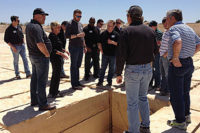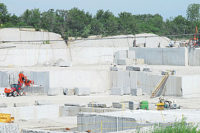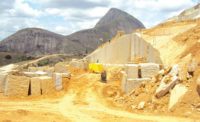From September 18 to 20, 2016 the MIA+BSI hosted a fall study tour in Vermont in conjunction with their newly formed New England Chapter. The 80-plus tour group visited eight different locations around the Vermont area, which has been known for its rich stone heritage. The three-day excursion not only provided a valuable learning experiencing, but it also offered sufficient time for networking and sharing ideas among stone industry professionals.
“We afford stone professionals the opportunity to get out of their own office/facility and travel to a destination for learning that cannot be duplicated in a classroom,” explained Jim Hieb, CEO of MIA+BSI. “There is something special about touring facilities and especially quarries. The quarry is what connects us to the product we sell. Whether you are a fabricator, installer or restoration professional — or you are the salesperson who sells it— there is a fascination with the origin of the product which is Mother Earth. The host companies also do a great job of showing off the best in the industry.
“The study tours are crafted in such a way where there is ample time to connect with other stone professionals,” Hieb went on to say. “Whether it is at the opening dinner, the bus time between stops or sharing a drink after a long day of touring, you can dive into the success and challenges that your attending peers are facing in their own business.”
The first stop on the trip was to the Vermont Granite Museum for a cocktail reception and dinner. The museum, located in Barre, VT, has a mission goal to preserve, honor and showcase Vermont’s granite industry and heritage. Members of the study tour were able to learn about the history of granite in Vermont, talk to sculptors and other members of the museum and to network with each other, learning about their businesses.
To start off the second day, the group went to the Bethel White quarry, operated by Rock of Ages, located in Granitesville, VT. The Bethel White quarry dates back to the 1800s and was among the first commercially operated quarries in the U.S., and material from the site was used for a range of historic buildings and national landmarks. The group was greeted by Bob Campo, vice president of quarry sales for Rock of Ages. In the past year and a half, Rock of Ages has expanded the quarry and has invested $5 million dollars into it. Campo also explained the quarrying process and the benefits of the stone. “We are in the process of working on a project in Paris,” said Campo. “It’s actually replacing Carrara marble that was used. Bethel White is a clean stone with very little veining.” The group was able to ask Campo about the quarry, how they extract blocks from the quarry, the use of wire saws and other topics they wished to know more about.
The second stop of the day was to Vermont Quarries, located in Mendon, VT. Owned by R.E.D. Graniti and Mazzuchelli Marmi of Carrara, Italy, the company has the largest underground marble quarry in the world. Danby marble has been used for a variety of buildings and national monuments, such as the Arlington National Amphitheatre, the Supreme Court and the Thomas Jefferson memorial. The group was met by Todd Robertson, the North American sales director, who showed them the Danby quarry. “The quarry works in different layers,” said Robertson. “If we start from the top, we would get Imperial, then next Olympian and it keeps changing as we go down.” Vermont Quarries also gave the group a live demonstration of how they remove the block that has been recently cut from the mountain wall.
After lunch the group stopped by Camara Slate Quarry and Yard, located in Fair Haven, VT. The quarries have been mined since the mid-1850s and the tour group was shown around by Shawn Camara. The group saw the mining location and how it’s processed. “You have a time frame of about four to six weeks to split slate,” said Camara. “After you split it after that time, all the moisture leaves the stone and you cannot split it again. Because of this, we have 90% waste with our product and only 10% yield.” The group walked through the slate processing mill and then through the roofing slate yard and shop.
The final stop of the day was to the Vermont Verde Antique quarry, located in Rochester, VT. Vermont Verde Antique is a dark green serpentine stone quarried in the Green Mountains of Vermont. John Fabbioli showed the group the 200-foot-deep pit where the stone is quarried. He also explained the future of the quarry. “We are currently making a new quarry floor,” said Fabbioli. “Then we are going to expand the quarry length wise. Our goal is to make it possible to drive down into the quarry.” The Vermont Verde Antique quarry not only quarries the stone, but they cut and sell the slabs themselves.
The last day of the tour started at Trow & Holden located in Barre, VT. From forging and forming to heat treatment and finish grinding, Trow & Holden has been making all its tools at its Barre, VT, location, for more than 120 years. The group was able to watch demonstrations of how the tools work and their abilities. Also, they were able to purchase any tools they wanted from the shop.
After visiting Trow & Holden, the group was divided, with one going to Buttura & Gherardi Granite Artisans and the other going to Hope Cemetery. Hope Cemetery, located in Barre, VT, was established in 1895 and originally contained 53 acres. Since then it has expanded to 65 acres. Visitors from all around the world come to see the cemetery and see the Barre Gray granite that is used for monuments and mausoleums.
The next stop was Buttura & Gherardi Granite Artisans, located in Barre, VT. The group was met by company President Mark Gherardi. The Buttura and Gherardi families immigrated to America from regions surrounding Carrara and Verona, Italy, in the early 1900s — each starting their own granite manufacturing businesses. Today, the two companies have merged to provide the finest quality memorial art. Gherardi walked the group around to show how the stones were polished and cut. They also walked through the studio sections where sculptors hand carved stone designs.
The final stop of the trip was to the E.L. Smith quarry owned and operated by Rock of Ages. The group was first brought up to take in the view from above the quarry and see the 600-foot-deep quarry that produces Barre granite. The group learned about the history of the quarry, as well as how it currently and used to operate. The group was then led through the company’s monument processing plant, to see how the monuments were cut and then assembled.
When the group was finished, they were brought back to the hotel where the Women in Stone (WIS) held a reception that allowed all the guests of the event to talk about what they had seen and experienced.
“We’ve been doing these tours for several years, and I must say that this one was probably the best orchestrated we have ever done,” said Hieb. “Some of that comes from experience, but some of it also comes from the collaboration between the MIA and the BSI. The combination of great industry volunteers and an excellent staff is key. The attendees — and their eagerness and excitement about the event — makes these events wonderful and a must-attend at some point in your professional career.
“In September 2017, we will be traveling to Indiana to showcase the limestone industry, rich history in the stone industry and more great networking opportunities,” Hieb continued. “It is also likely that an international delegation of stone professionals will be attending the event, which will certainly add to the flavor of the event and enhance the networking opportunities.”












